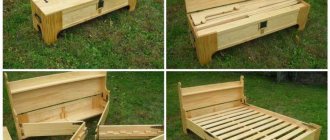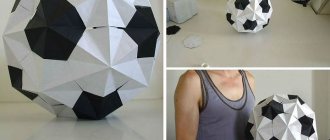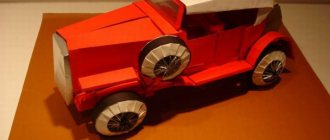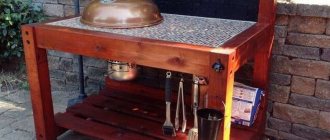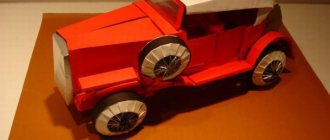DIY electric car for children, Project No. 2
DIY electric car for children
How we made an electric car 2
and here it is - the continuation.
We drove the first car for two seasons (now it is gathering dust in the garage). At first she seemed so beautiful, but now, having soberly assessed her appearance, we are horrified. My son has grown up, his view on the aesthetic side of the car has changed, maybe there are some other reasons, but car 1 was no longer suitable, but he wants to ride... As usual, my parents don’t have money (no, we’re not greedy, prices just went up again). In short, it's time to make car-2.
There were several nuances: 1. The car had to be as large and powerful as possible and at the same time fit into an ordinary elevator, fit through the doors of an ordinary apartment and be light. 2. Consume little energy. 3. Be beautiful. 4. Other incompatible requirements. 5. The total power of the engines is at least 180 watts. 6. Having experience with car 1, it was decided that brakes are a MUST. 7. Smooth “gas”, i.e. an electronic engine control circuit was needed. 8. Inflatable wheels.
250 watt (very tempting in terms of power) from UAZ or Volga were not suitable for two reasons. 1. expensive (1000 rubles per piece). 2. current consumption is quite large.
There were 110 watt ones left from VAZ, and they were bought for 450 rubles. per piece
After purchasing the engines, the question became, how will the torque be transmitted to the wheels?
After numerous experiments, it was decided that the rubber band was cut from the inner tube of a passenger car. And therefore, pulleys for the wheels and for the engine were ordered from the turner at the factory. According to the drawing I gave. The turner was a MONSTER and from a sheet of iron using a machine and a torch he created these pulleys
I want to warn those who will repeat my actions. As it turned out, for a flat belt drive you need BARREL-SHAPED pulleys, otherwise the belt crawls out from the pulleys... I didn’t want to redo anything and didn’t intend to and got out of this situation by cutting one wide belt into 4 thin ones
The circuit of the entire car was modified for use as an engine regulator; some elements were added. The power transistor was placed on the heatsink from the processor.
Steering wheel...needed a small steering wheel...where to get one? We thought of all sorts of thoughts, but we had to go to the car market and fork out 500 rubles. like a real sports steering wheel from a real car.
Now we need to buy additional plywood, more bolts, radio components, sensors... well, a lot of other small things... And some of them you can’t find in our city at all - you have to order them. Weld the pedals..., buy paint, work, horror in short.
But now you can cook the frame!
Park and slowly assemble the car.
More than one day was also spent on the electrical circuit.
After sawing off the excess and filing it, we took it to the garage.
We are already in the garage (the mother kicked the children out of the house so as not to stink of paint) priming the car. All that remains is to pull the pieces of rubber hose onto the bumpers (dear dog)
and install a bike computer (shows speed, distance traveled....and a bunch of all sorts of data...the wheel size is adjustable, so it shows quite accurately),
and install a 75 A/h battery,
Source
What is a velomobile
If you look closely at the word “velomobile” itself, you can assume that it is something between a bicycle and a car. In general, this is true. The velomobile is driven, like a bicycle, by muscle power. Only unlike a bicycle, a velomobile allows you to feel more comfortable. Velomobiles have a car-like seat, a fairing, and sometimes even a roof. Agree, it is much safer to travel on such a device than on a bicycle. In addition, you will certainly become the center of everyone's attention.
TOP 5 touring velomobiles in the world
So, let's name the advantages of a velomobile:
- comfort;
- safety compared to a bicycle;
- an opportunity to stand out from the crowd.
You can easily move around the city with a velomobile
Among the disadvantages it should be noted:
- cumbersome design;
- high prices.
A velomobile can be assembled from a regular bicycle. Therefore, it is more likely to sort out the trash on the balcony, in the garage or in the country house. Patience, hands, tools and supplies will also certainly come in handy.
What is the difficulty of creating a children's electric car from scratch?
The main design goal when creating a children's electric car is to ensure the reliability of the product with optimal dimensions and weight. A heavy, substantial-sized device will be too heavy for a child and his mother to lift, and will also cause a lot of trouble with transportation in an elevator and storage. Also, a bulky body requires a more powerful engine and a larger battery, and this again entails weight and requires strengthening of the frame and chassis.
The design of the body or frame on which all components and mechanisms are supported is the work of engineers. And therefore, when assembling a homemade children's electric car, you can significantly simplify your task by using a ready-made design for a children's car with pedals or an ordinary pusher.
If, nevertheless, looking for easy ways is not for us or we plan to get a powerful base with the possibility of later converting it into a teenage go-kart or buggy, on the Internet you can find a variety of drawings according to which you can make a children’s electric car.
But the best option would be to create your own, taking into account the selected components and materials. Having basic design skills, you can create an optimal model with all the characteristics, and even design it according to the order of the young driver.
Two-wheeled recumbent velomobile
Such velomobiles are called legeradas, which translates from German as “lying on a wheel.”
It is pleasant to ride on such a velomobile on country roads, because it easily picks up high speed due to good aerodynamics. Another feature of ligrades is the position of the cyclist: the rider is in a supine position, which reduces the load on the lower back and helps maintain health. Unfortunately, the cost of such devices is comparable to the price of a used car. Even if you make it yourself, it will be the most expensive .
To assemble a recumbent velomobile we will need:
- two mountain bikes with wheels 26 and 20 inches;
- profile pipe (about 3m);
- a piece of steel plate;
- metal rod (about 1 m);
- Chipboard, foam rubber and seat upholstery.
We start, of course, with the frame, which will be made of a profile pipe. All sizes must be adjusted to suit you. If you are not sure, it is better to increase the base a little so that you can move the seat later.
The frame of the velomobile is made of a profile pipe
The rear part is made from a large mountain bike, so we take the carriage from it, the gear shifter with the entire bushing, and from it we cut off the rear triangle on which the wheel is attached. Let's transfer this to the frame of the future leaguer. The carriage from a small bicycle will become the front carriage of a velomobile.
We weld the carriage to the lower frame tube
A special feature of this velomobile is the intermediate drive. Thanks to it, the chain will sag less, and therefore fly off too.
Install several washers between the inner sprocket and the middle drive to prevent the front chain from interfering with the rear chain.
The steering column with a glass is taken from a large bicycle. The handlebar will be approximately 650mm behind the pedal assembly. It is connected to the front fork using a metal rod. It turns out to be a kind of steering rod.
The rod is attached to a steering bracket welded to the front fork
We make the seat from plywood, choose the upholstery, foam rubber and tilt angle at your discretion. Having achieved a convenient location, we attach it to the frame using bolts.
This velomobile is easy to ride, despite its length. It's quite dynamic and handles well, with responsive steering. At first it will be scary to drive among cars, but there is nothing to fear: such a vehicle will immediately catch your eye. It will be difficult to remain unnoticed.
Advantages of a recumbent velomobile:
- comfortable fit;
- maintaining health;
- fall safety (compared to a bicycle);
- good aerodynamics.
Flaws:
- high price;
- complexity of the design.
Manufacturing sequence
First, let's decide on the design, because for children, appearance is very important. There are no restrictions here, and if we make the body ourselves, we can copy it from any children’s or adult’s car. In addition, you can develop a design in the form of an airplane, ship, rocket or some other animal.
We will think over the type of control, steering and brake mechanisms, select components from those available on the farm or available for sale.
Next, we assemble all the components together, for fastening we use the necessary screws, angles, clamps, you can resort to welding or soldering the seams.
It is advisable to make the frame more compact, taking into account the dimensions of all components, with reliable joining of the elements. Thus, the car will be stronger, more maneuverable and lighter, this will allow you to get by with a simpler motor and battery.
What to make the body out of
Traditionally, kids' car frames have been made from steel or wood by dads for centuries. But now more modern materials are available, which are in no way inferior to metal in construction. For example, from PVC pipes you can easily cut and solder a strong base that can withstand heavy weight, vibrations and shocks: cutting and soldering this material is not difficult, the corners will be smooth, injury-proof, and the structure will not make noise when driving.
Selecting an electric motor
The engine for an electric vehicle can be selected from any equipment powered by a voltage of 12-24 volts, for example, car engines.
For the smallest children - on pushers - a windshield wiper gear motor is suitable, developing a decent traction force at a speed of 1-2 km/h with a power of only 7-20 W.
For fast driving you will already need motors from 100 W, for example, from a cooling system fan. A motor made from a screwdriver is also perfect, which can be used in conjunction with the “original” gearbox and speed controller.
Battery selection
The power source can be used ready-made, rated 12-24 volts; the following are suitable for this purpose:
You can also assemble a battery from available cells, such as phone batteries or 18650 cells used in screwdrivers and laptops, by soldering them in series and placing them in a suitable case (or wrapping them with electrical tape).
Organization of engine power supply
An excellent option would be to connect a two-stage button or accelerator pedal with the first position through a resistor, and the second directly. The starting current will be significantly lower, which will extend the driving time until complete discharge.
But it’s best to use a PWM controller, either from the same screwdriver, or assembled yourself. With pulse-width control, the speed varies very smoothly, without loss of torque.
The standard screwdriver button may overheat and fail under increased loads and prolonged driving. So it’s better to immediately improve the smooth operation by installing an enlarged radiator on the chip, and take care of its good airflow.
Charger
Charging should be selected depending on the battery used. You can find any chargers on sale, both for specific batteries with a specific rating, and universal ones, with adjustable voltage and current.
Steering and braking options
When designing a frame, the first thing you need to think about is how to control the children's transport. This will require a real steering mechanism with a good margin of safety, especially for more “adult” models. It can be done following the example of pushers, when the wheels are fixed on one rigid axle and attached to the base with a bushing under the steering wheel.
Four-wheeled two-seater velomobile
Four-wheeled velomobiles are less common than three-wheeled ones
Essentially, these are two bicycles united by one frame. The frame is made of steel pipes. Its dimensions depend on the height of the driver. In addition to the frame, major changes are made to the steering. The two front forks are connected using a rod. One of the features worth noting is the double pedal assembly. Each rider has his own. Only the chain length is changed here. The brakes on the rear wheels remain original.
How much will the venture cost?
In the case of remaking a finished machine, you only need to install a motor and organize a chain drive. The wear of the motor will be small, so you can stop at a used one, the price of which starts at 250 rubles.
The sprockets are suitable for bicycles; together with a flail, they can be found on the market and will cost from 200 rubles. For a belt drive, you can make a pulley yourself, from plastic or wood, attach it to a drill for scrolling and cut a landing groove with a file. The belt is taken ready-made - from any equipment, or a round strip is cut out from a car inner tube.
The battery will cost from 350 to 1000 rubles. Even its minimum capacity is enough for half an hour of driving, and stops to communicate with friends will stretch the pleasure for a whole half day.
Simple charging - another 200 rubles.
Design of main components
To transmit rotation from the steering wheel, we decided to use a cord. The steering column, winding the cord will control the steering beam. We wind two turns on the column, then through the eyes on the left and right sides we fasten the cord to the edges of the beam with screws.
The gear ratio of the drive sprocket to the driven sprocket is 2:1. Sprockets, pedals and chains taken from a children's bicycle. Wheels taken from an old stroller. They are fastened using locking rings, which makes it possible to quickly replace them in the event of a sudden breakdown. The website umeltsi.ru has the exclusive right to display a master class of this velomobile.
Modernization and tuning of a children's electric car
It is quite convenient to make the body more voluminous or make it yourself from polyurethane foam, which can be shaped with a stationery knife and sandpaper. Next comes the standard puttying and painting procedures.
Upgrading the chassis may involve adding springs or rubber inserts to the suspension for shock absorption. Ball bearings are installed at friction points.
It is also possible to tune the power part by replacing the engine with a more powerful one or changing the transmission gear ratio, for example, by replacing a sprocket. Remaking the gas regulator in some cases can add a little speed. You can also increase the “maximum speed” by increasing the drive wheels - by replacing them or, for example, by wrapping tires from a tube around the tread.
You can always replace the battery with a more capacious one or deliver more cells to the free cavities of the body.
Inside some remote controls, manufacturers provide for adjusting the signal strength, and if you have been thinking about how to increase the range of the remote control, try to find a small regulator inside for a screwdriver and twist it slightly to measure the maximum response length.
Let's cast aside doubts
For decades, parents all over the world have been giving their children handmade cars with motors, and today, when stores are filled with ready-made parts and affordable materials, it is becoming much easier to make such a miracle of technology.
All you need to get started is a simple design of sufficient strength with an eye to a future adult version. Next, using experience and recommendations that are abundant on the Internet, we assemble a model to order from a young car enthusiast. Over time, ideas will come about what and how to improve.
The child himself will become your skillful assistant, at the same time gaining design experience, which will be useful in life.
Source

